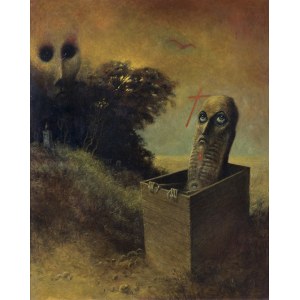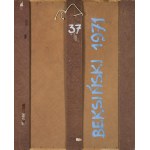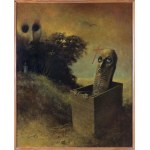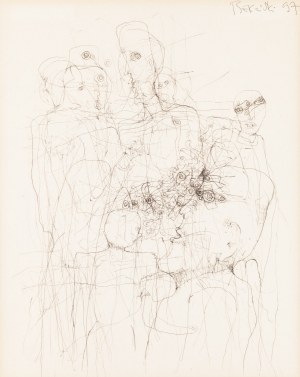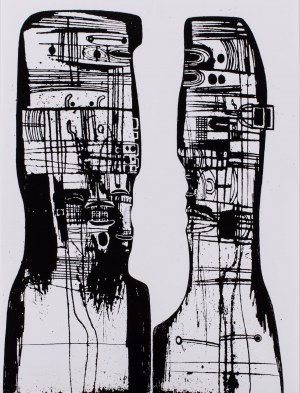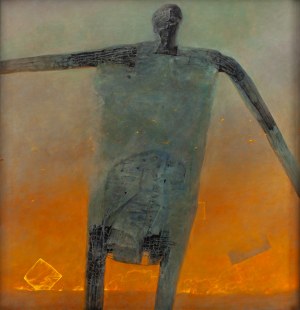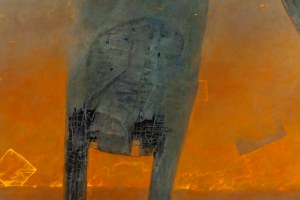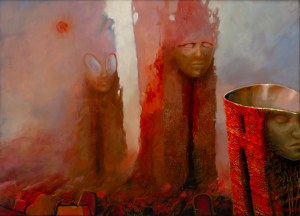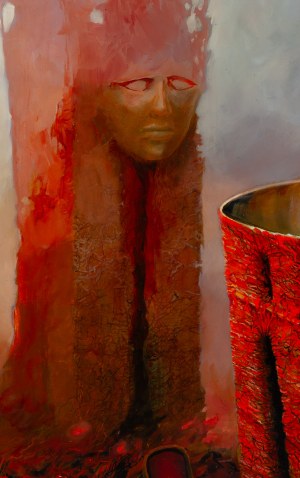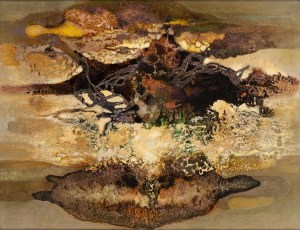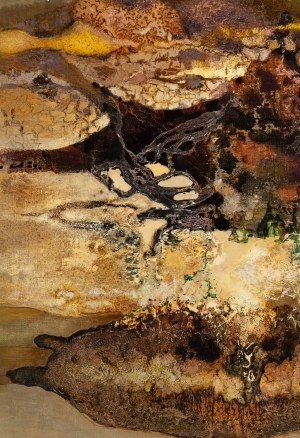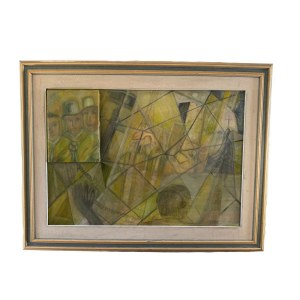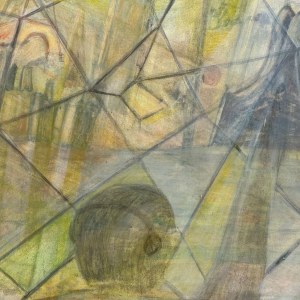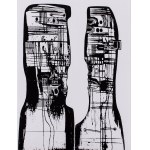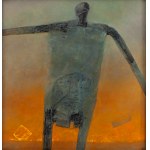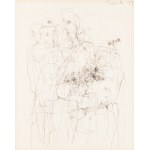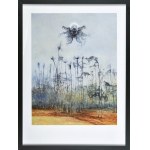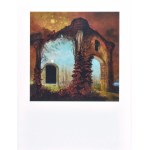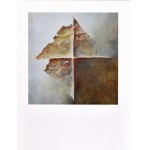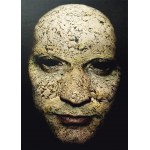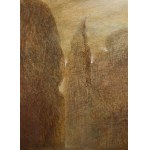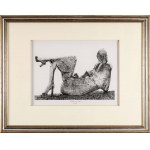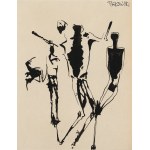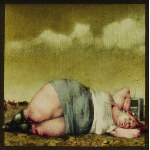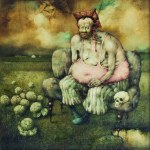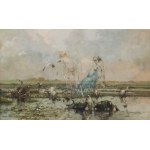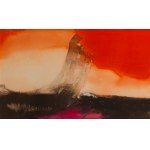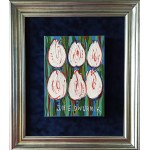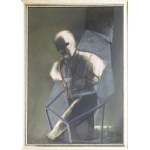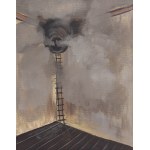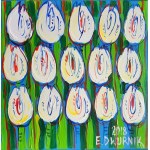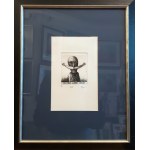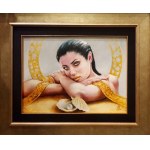92.0 x 79.5cm - oil, fiberboard on center reinforcement of panel: no. in silver paint: 37, above in marker 96/1212, at d. fragment of sticker, p.g.: export stamp.
Provenance: Private collection, Czech Republic.
The early 1970s was a special moment in Zdzislaw Beksinski's long career. After a fascination with abstract art and creative experiments with sculpture and photography, the artist devoted himself entirely to learning the craft of painting. Hours of work spent at the easel eventually allowed him to "photograph" the visions that haunted him in so-called metaphysical landscapes. A common feature of his early works was, above all, the presence of disturbing designations of death and a dark, depressing color scheme. The famous "thriller" series is perfectly represented by the composition offered in this catalog, which depicts a scene close to a nightmare. The characters and props taking part in it - a scarlet figure from hell, a supernaturally sized phantom face, tombstones, the sign of the cross - create a ghastly staffage in a seemingly ordinary landscape. The drastic content conveyed by the paintings created in 1971-1972 received a lively response from the public and resonated in the press of the time. In the pages of Artistic Review, they were reviewed: The repulsively degenerate shapes, ambiguous poses, helpless gestures of these menacing, yet tormented creatures, crawling or cowering amidst gloomy, dramatic landscapes with skies shining with a distant, cold glow - arouse horror and compassion at the same time. The symbolism of the depicted scenes is quite unambiguous, the metaphor is strong, crude and brutal. The exaggerated, caricatured vision of the world and man may shock - but this is precisely the artist's goal (quoted in T. Sowińska, Phantoms and Sphinxes, "Przegląd Artystyczny", No. 3 (73), 1973, p. 14).
The anecdotal and elaborate scenery of the "landscapes" prompted viewers to spin interpretations and multiply meanings. Most of them boiled down to accusing the artist of promoting cruelty and deliberately inflicting suffering. The artist countered the attacks, stating: The authors of the accusations do not distinguish between expressing in a painting the author's mental state or spiritual distress and a strictly realistic description of the macabre, which I never did and do not do (quoted in: Meaning is meaningless to me. Zdzislaw Beksinski is interviewed by Zbigniew Taranienko, "Art," No. 4/6, 1979, p. 34). In the end, the voices of criticism did not discourage the public, but - on the contrary - made the painter's work famous, which has since enjoyed unflagging interest from collectors.
♣ to the auctioned price, in addition to other costs, will be added a fee resulting from the right of the artist and his heirs to receive remuneration in accordance with the Law of February 4, 1994 - on Copyright and Related Rights (droit de suite)
(Sanok 24 II 1929 - Warsaw 21 II 2005) studied from 1947 to 1952 at the Faculty of Architecture of the Cracow University of Technology.
He was a self-taught artist who achieved an unquestioned position in Polish contemporary art, confirmed by the presence of his works in prestigious exhibitions and museum collections. He was initially involved in photography, which he had been interested in since his student years, after 1956 gaining recognition as a creator of photograms with an aesthetic based on textural effects. In 1958-1962, he created abstract paintings-reliefs of rich texture, mainly metal, which are a variation of matter painting. Toward the end of this period, he created openwork forms with figure shapes and full-bodied sculptures in metal. The next stage of his work was 1962-1974, when he devoted himself mainly to drawing. In the 1960s he drew with pen and ink figural compositions characterized by caricatured deformation of figures. From the late 1960s, he created charcoal and crayon drawings, a monochromatic variant of his parallel painting work. Since 1974, he has dealt almost indivisibly with painting. His distinctive style was based on technical perfection, accompanied by an extraordinary vision. He painted a post-disaster world, marked by the stigma of death and decay. His paintings are populated by figures and creatures with admittedly human or animal shapes, but with the characteristics of phantoms, automatons or decaying corpses. The artist did not give his paintings and drawings titles (except for ordering symbols), thus emphasizing his lack of interest in the literary side of the depictions. He himself said that when painting he completely surrenders to the vision, "photographing" it. In recent years, he has incorporated electronic image generation techniques into his artistic technique, which he used to create computer photomontages. Beksinski's art, which has been exhibited and discussed many times, arouses extreme emotions among experts and the public.
The largest, systematically replenished collection of his works in the country is in the Historical Museum in Sanok, abroad - in Paris, in the possession of Piotr Dmochowski, who has been collecting works and promoting the artist's work since 1983. He organized individual exhibitions of Beksinski's works at, among others, Galerie Valmay in Paris in 1985, 1986 and 1988, as well as a permanent exhibition at Dmochowski's own Galerie - Musée-galerie de Beksinski, which existed from 1989 to 1996. He also published monumental albums of the artist in 1988 and 1991.
In Poland, Beksinski's monograph by Tadeusz Nyczek was published by Arkady in 1989 (second edition in 1992). In the spring of 2005, a major exhibition of Beksinski's paintings took place at the Abbotsford Palace in Gdansk Oliva, and the director of the Sanok Museum Wieslaw Banach published a comprehensive monograph on the artist.
Since October 2016, an exhibition of 250 works (paintings, drawings, photographs) by Zdzislaw Beksinski from the private collection of Anna and Piotr Dmochowski has been permanently installed at the Nowa Huta Cultural Center. Meanwhile, a permanent exhibition of 30 Beksinski paintings from the Dmochowskis' collection has also been on display at the Archdiocese Museum in Warsaw since June 2021.
(Photo: Piotr Dmochowski, CC BY-SA 3.0, https://commons.wikimedia.org/w/index.php?curid=8960820 )
Recently viewed
Please log in to see lots list
Favourites
Please log in to see lots list



